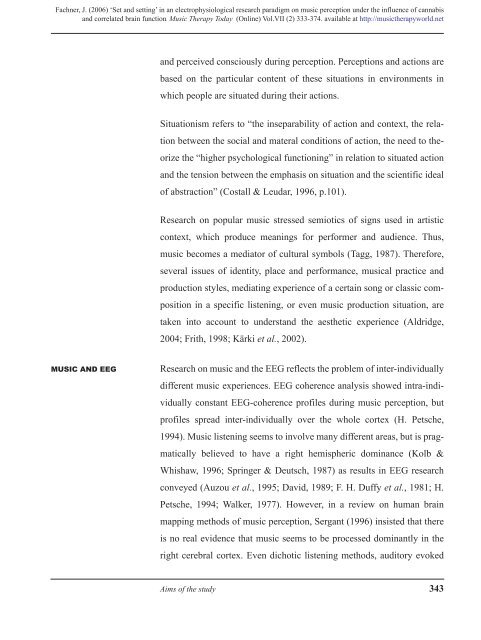Music Therapy Today - World Federation of Music Therapy
Music Therapy Today - World Federation of Music Therapy
Music Therapy Today - World Federation of Music Therapy
You also want an ePaper? Increase the reach of your titles
YUMPU automatically turns print PDFs into web optimized ePapers that Google loves.
Fachner, J. (2006) ‘Set and setting’ in an electrophysiological research paradigm on music perception under the influence <strong>of</strong> cannabis<br />
and correlated brain function. <strong>Music</strong> <strong>Therapy</strong> <strong>Today</strong> (Online) Vol.VII (2) 333-374. available at http://musictherapyworld.net<br />
and perceived consciously during perception. Perceptions and actions are<br />
based on the particular content <strong>of</strong> these situations in environments in<br />
which people are situated during their actions.<br />
Situationism refers to “the inseparability <strong>of</strong> action and context, the rela-<br />
tion between the social and materal conditions <strong>of</strong> action, the need to the-<br />
orize the “higher psychological functioning” in relation to situated action<br />
and the tension between the emphasis on situation and the scientific ideal<br />
<strong>of</strong> abstraction” (Costall & Leudar, 1996, p.101).<br />
Research on popular music stressed semiotics <strong>of</strong> signs used in artistic<br />
context, which produce meanings for performer and audience. Thus,<br />
music becomes a mediator <strong>of</strong> cultural symbols (Tagg, 1987). Therefore,<br />
several issues <strong>of</strong> identity, place and performance, musical practice and<br />
production styles, mediating experience <strong>of</strong> a certain song or classic com-<br />
position in a specific listening, or even music production situation, are<br />
taken into account to understand the aesthetic experience (Aldridge,<br />
2004; Frith, 1998; Kärki et al., 2002).<br />
MUSIC AND EEG Research on music and the EEG reflects the problem <strong>of</strong> inter-individually<br />
different music experiences. EEG coherence analysis showed intra-indi-<br />
vidually constant EEG-coherence pr<strong>of</strong>iles during music perception, but<br />
pr<strong>of</strong>iles spread inter-individually over the whole cortex (H. Petsche,<br />
1994). <strong>Music</strong> listening seems to involve many different areas, but is prag-<br />
matically believed to have a right hemispheric dominance (Kolb &<br />
Whishaw, 1996; Springer & Deutsch, 1987) as results in EEG research<br />
conveyed (Auzou et al., 1995; David, 1989; F. H. Duffy et al., 1981; H.<br />
Petsche, 1994; Walker, 1977). However, in a review on human brain<br />
mapping methods <strong>of</strong> music perception, Sergant (1996) insisted that there<br />
is no real evidence that music seems to be processed dominantly in the<br />
right cerebral cortex. Even dichotic listening methods, auditory evoked<br />
Aims <strong>of</strong> the study 343

















